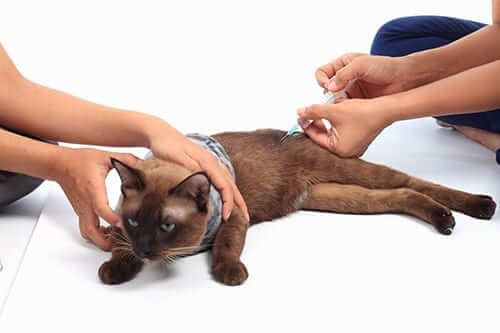Last week I met the cutest lady. Her plate is full. She is taking care of her 99 year old mother. Her husband is about to have surgery. And she recently adopted a chubby cat who has been drinking a lot since she rescued her 2 months ago. The kitty is a sweetheart but her prior human had health issues and moved away without her. She was very timid in her new home. Thus far she has spent a fair bit of time under the bed.
I did my usual initial diabetes diagnosis routine for this lady. We had a diabetes lesson, and I got her started with insulin and needles. Then I sent her home with a pile of “homework” (articles about diabetes), a blood glucose meter and my most sacred gift of all – my cell phone number. I also sent her with a little sock of uncooked rice. Whenever I send a glucose meter home with someone I also send a small sock of uncooked rice. It can be warmed in the microwave and held by the blood collection site for a few seconds before using the lancing device. Boy does this warmth and vasodilation make it easier for clients to get blood from their critters! I had her come back the next morning for her to practice blood collection with a lancet and use the meter again and for me to watch her as she gave an insulin injection. I find that initial daily check-ins and hand-holding result in good client habits and better diabetes control for my patients.
Two or 3 days into her treatment I got a text that she couldn’t get her kitty out from under the bed when she was due for her injection and meal. As you might guess, my client was anxious that her cat would deteriorate and that her efforts were doomed. Had she bitten off more than she could chew with her new pet? No. I told her to relax. All will be well. I figure most of the time her kitty has been in her new home she hasn’t been feeling well due to her undiagnosed diabetes. As she starts to feel better with the insulin Dose and low carb diet and as she gets used to her new humans, she will likely gain confidence and venture out from under the bed more often. She’s a very sweet kitty and I have no doubt that as we get her diabetes under control she will, like most cats, become the boss of the house.
 So what happens if a diabetic pet misses a periodic insulin dose? Of course we don’t encourage missing medication, but life happens. Sometimes a meeting runs hours late or you find yourself in a traffic jam. Life is not perfect! In general, if you are more than 2 or 3 hours late I’d probably skip the insulin dose for that dose and wait until the next dose is due. If you give a dose late and the following dose is given at the regular time, the effects of the insulin could compound and you might find yourself with a hypoglycemic pet. A short period of a high blood glucose, say from a missed dose, is safer than a short period of low blood glucose.
So what happens if a diabetic pet misses a periodic insulin dose? Of course we don’t encourage missing medication, but life happens. Sometimes a meeting runs hours late or you find yourself in a traffic jam. Life is not perfect! In general, if you are more than 2 or 3 hours late I’d probably skip the insulin dose for that dose and wait until the next dose is due. If you give a dose late and the following dose is given at the regular time, the effects of the insulin could compound and you might find yourself with a hypoglycemic pet. A short period of a high blood glucose, say from a missed dose, is safer than a short period of low blood glucose.
Let’s go back to signs of high blood glucose and low blood glucose. For our seasoned diabetic pet owners this is old hat. For new diabetic pet owners, I’ll explain that a high blood glucose overwhelms the kidneys ability to concentrate the urine. It’s the theory of osmosis; what we all learned about in high school chemistry class. If the blood glucose is high (over about 250 to 300mg/dl) then the kidneys can’t concentrate the urine. A diabetic pet then has dilute urine – even if the pet is dehydrated. The pet has to drink lots of fluids to try to stay hydrated. The most common sign of an unregulated diabetic is increased thirst and increased urination. In contrast, a low blood glucose manifests with weakness and hunger. The pet might act drunk or shake. If the blood glucose, gets down to 20 or 30 mg/dl the pet might even have a seizure.
Now don’t think I’m telling you to skip insulin doses on a regular basis! What I’m saying is that a short period of a high blood glucose is much safer than a short period of a low blood glucose. A well-regulated diabetic pet won’t go into a diabetic crisis by missing a single insulin dose now and then. If your day becomes the perfect storm of unforeseen events and you miss Fluffy’s insulin injection, don’t beat yourself up. Tomorrow is another day!
You know I like hearing from our readers. Don’t hesitate to email me at [email protected]
NOTE: Consult your veterinarian first to make sure my recommendations fit your pets special health needs.










Leave A Comment